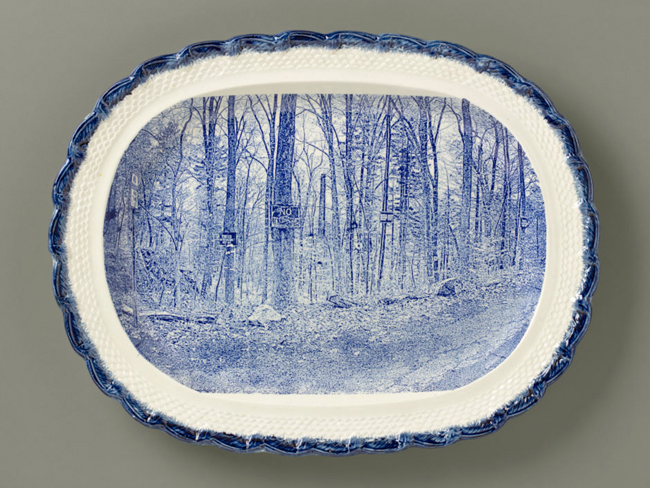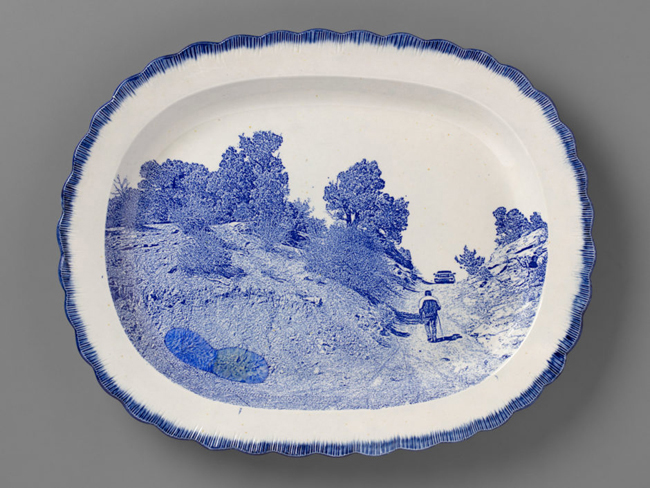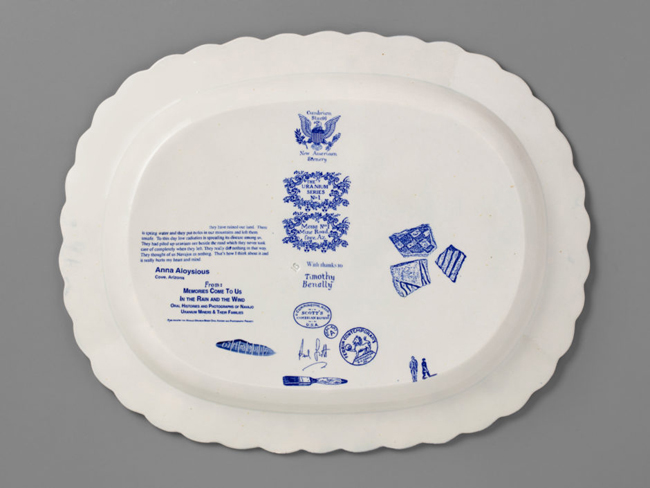Paul Scott’s Valuable Lessons
Lyn Horton
December 2019
 Scott’s Cumbrian Blue(s), New American Scenery, Ohio, 2019, in-glaze screen print (decal)
Scott’s Cumbrian Blue(s), New American Scenery, Ohio, 2019, in-glaze screen print (decal)
on salvaged Syracuse China with pearlware glaze, 12 x 12 x 1.25″.
Artists are compelled in days, months and years of global confusion to apply their own language to construct their individual perspectives for the purpose of clarifying and pointing out for an audience, most often specifically, what is happening.
Ceramic artist, an Englishman from Cumbria, Paul Scott has seized upon the opportunity to fulfill that purpose. Scott is thoroughly versed in the history and the studio actualization of transferware. Transferware is so close to our existence that we can barely notice it. It is the art form that has become the “souvenir” to make memories of places tangible. These objects can be collected and displayed to document one’s travels, experiences, and predilections. Of the world of transferware, Scott wants people to know: “One of the things you have to realize is that when originally made, transferware was a commercial product. It was made to sell to people, to make money.”
 Scott’s Cumbrian Blue(s), New American Scenery, Near the Oxbow (after Thomas Cole), 2019,
Scott’s Cumbrian Blue(s), New American Scenery, Near the Oxbow (after Thomas Cole), 2019,
in-glaze screen print (decal), on shell-edged pearlware platter c.1850, 13.5 x 16.75 x 2″.
Over a period of five years, Scott plunged headlong into an epic research and travel adventure in the United States which yielded tens of original plates identifying his singular visions. Scott’s process is both intellectual and hands-on. A particular plate that is not of his own making might propose an opening into which he can jump and seize on to the elements of his own lexicon of collage, erasure and cutting to recreate a platter or plate to reveal his view, and tell his story.
Scott juxtaposes the traditional elements and designs of transferware with disturbing images emanating from his research. This gesture requires that one really look at the plate, examine it for the statement he is making. He places, within the elegant rich blue result of firing the plate, decals, prints of photos, or arresting engraved images. He stirs a pot of components and pulls out of the stew an object that strikes the viewer as uncommon, un-idealized, un-“sanitized.”
 Scott’s Cumbrian Blue(s), New American Scenery, The Uranium Series No. 1 Messa No: 1,
Scott’s Cumbrian Blue(s), New American Scenery, The Uranium Series No. 1 Messa No: 1,
Mine Road Cove, AZ, 2019, in-glaze screen print (decal), on shell-edged
pearlware platter c.1840 with uranium glass, 13.5 x 16.5 x 2″.
That an artist can feel free to rearrange what already exists into something new is how impressive art can be created. Scott simply takes the beautiful elements of nineteenth century English Staffordshire blue and white transferware originally brought into the United States as a popular means to convey “pictures” of record, and plugs in his own exemplary pictures: of nuclear plants; land despoiled by chemical pollution; portraits of disenfranchised people, innocent imprisoned people, estranged persons who have been ravaged by corporate greed; the border wall between Mexico and the United States; abandoned factories; or once accessible scenic environments. Unsettling images couched in the “Cumbrian” blue of Scott’s transferware do not make them any less palatable. In fact, and obviously, the elegant borders, made up of exquisitely drawn flora, sometimes on a salvaged and recycled plate, often frame these images and render them more distressing.
In his process, Scott has not necessarily produced “new” products. He has culled from a variety of “found” materials, the materials for his own use. He reclaims rejected porcelain plates either virgin or already occupied with images. He literally cuts out what he needs, he erases what he does not need. He replaces old image forms with new ones. He re-glazes, reprints and repurposes what already exists. Each plate, platter or pitcher has its own unique non-conformist history. One must also absorb the tales on the back or bottoms of these newly executed pieces, on which are placed assignations, stamps, or stencil prints in ways that become artworks unto themselves.
 Scott’s Cumbrian Blue(s), New American Scenery, The Uranium Series No. 1, Messa No: 1,
Scott’s Cumbrian Blue(s), New American Scenery, The Uranium Series No. 1, Messa No: 1,
Mine Road Cove, AZ, back, 2019, in-glaze screen print (decal), on shell-edged
pearlware platter c.1840 with uranium glass, 13.5 x 16.5 x 2″.
The conceptual aspects of how Scott works is key to the appreciation of his inventiveness. Scott brings to ceramic art true unadulterated meaning. He wants his audience to see in a certain way; the polarization of form and content exaggerate and strategically thrust his statements at the viewer.
If the works comprising the show New American Scenery cast so much honesty and truth that hope is dispelled, one can turn to the triptych where Scott has broken three pristine platters in specific spots and inserted broken parts of another broken plate so that parts of one scene are spread across three units. He has sealed the foreign elements into the clear immaculate planes of the new platters using the ancient oriental art of kintsugi. A gold line heals unrelated components into a new body. However wide this stretch of interpretation is, it certainly can offer breathing space and perhaps a way to know that we can continue, in art especially, in the bleakest of eras, in the darkest of times.
 Scott’s Cumbrian Blue(s), New York Battery Park Tryptych, Fragmented Enoch Wood & Sons New York Battery Park
Scott’s Cumbrian Blue(s), New York Battery Park Tryptych, Fragmented Enoch Wood & Sons New York Battery Park
platter c.1825, collaged (with kintsugi) into three Leeds Pottery shell edged pearlware platters c. 1840, 2016 & 2019.
All images permission of Ferrin Contemporary.
New American Scenery is on exhibit at RISD Museum through September 6, 2020 and will be presented in an expanded exhibition at Albany Institute of History & Art, September 16, 2020- January 3, 2021.
Paul Scott’s solo exhibition at Ferrin Contemporary will present selected works from the series at Ferrin Contemporary in April 4 – May 17 in North Adams, MA.
◊
Lyn Horton has been an artist for over forty years dedicated to maintaining a whole life experience now more than ever. She has a long history writing about creative improvised music for well-known publications, reviewing recordings, interviewing musicians and composing editorials. She has exhibited her art work extensively and is represented by the Cross MacKenzie Gallery outside of Washington, D.C. Horton was commissioned in 2012 to do a piece for the US Embassy in Vientiane, Laos. Her photography can be seen on Instagram.
